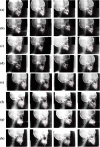Ceph-Net: automatic detection of cephalometric landmarks on scanned lateral cephalograms from children and adolescents using an attention-based stacked regression network
- PMID: 37884918
- PMCID: PMC10604948
- DOI: 10.1186/s12903-023-03452-7
Ceph-Net: automatic detection of cephalometric landmarks on scanned lateral cephalograms from children and adolescents using an attention-based stacked regression network
Erratum in
-
Correction: Ceph-Net: automatic detection of cephalometric landmarks on scanned lateral cephalograms from children and adolescents using an attention-based stacked regression network.BMC Oral Health. 2024 Feb 1;24(1):165. doi: 10.1186/s12903-023-03804-3. BMC Oral Health. 2024. PMID: 38302984 Free PMC article. No abstract available.
Abstract
Background: The success of cephalometric analysis depends on the accurate detection of cephalometric landmarks on scanned lateral cephalograms. However, manual cephalometric analysis is time-consuming and can cause inter- and intra-observer variability. The purpose of this study was to automatically detect cephalometric landmarks on scanned lateral cephalograms with low contrast and resolution using an attention-based stacked regression network (Ceph-Net).
Methods: The main body of Ceph-Net compromised stacked fully convolutional networks (FCN) which progressively refined the detection of cephalometric landmarks on each FCN. By embedding dual attention and multi-path convolution modules in Ceph-Net, the network learned local and global context and semantic relationships between cephalometric landmarks. Additionally, the intermediate deep supervision in each FCN further boosted the training stability and the detection performance of cephalometric landmarks.
Results: Ceph-Net showed a superior detection performance in mean radial error and successful detection rate, including accuracy improvements in cephalometric landmark detection located in low-contrast soft tissues compared with other detection networks. Moreover, Ceph-Net presented superior detection performance on the test dataset split by age from 8 to 16 years old.
Conclusions: Ceph-Net demonstrated an automatic and superior detection of cephalometric landmarks by successfully learning local and global context and semantic relationships between cephalometric landmarks in scanned lateral cephalograms with low contrast and resolutions.
Keywords: Cephalometric analysis; Cephalometric landmark; Deep learning; Landmark detection; Scanned lateral cephalogram.
© 2023. The Author(s).
Conflict of interest statement
The authors declare no competing interests.
Figures








References
-
- Qian J, Luo W, Cheng M, Tao Y, Lin J, Lin H. CephaNN: a multi-head attention network for cephalometric landmark detection. IEEE Access. 2020;8:112633–112641. doi: 10.1109/ACCESS.2020.3002939. - DOI
-
- Juneja M, Garg P, Kaur R, Manocha P, Batra S, Singh P, et al. A review on cephalometric landmark detection techniques. Biomed Signal Process Control. 2021;66:102486. doi: 10.1016/j.bspc.2021.102486. - DOI
MeSH terms
LinkOut - more resources
Full Text Sources

